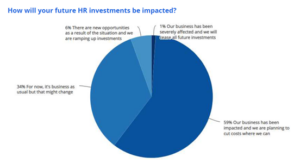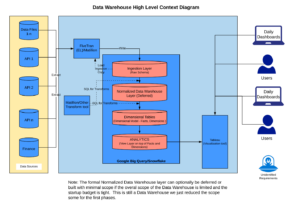>A recent survey by Raven Intel (see article this issue) concluded that, due to COVID 19, at least 60% of companies surveyed said that they were cutting costs where they can or will completely cease all investments in HR technology. While we’re dealing with the virus, and for the foreseeable future afterward, HR technology investment will doubtless suffer.

Courtesy of Ravin Intel COVID19 Impact Study
That doesn’t mean that we need to stick with the pain points that prompted action altogether though. If you’re a medium to large organization, the leading cloud-based Human Capital Management (HCM) systems can cost a few million dollars annually, with additional millions for the initial implementation. The break-even point and return on investment is dubious at best (if you’re looking only at quantitative measures). But there are low or no-cost options that can fulfill tactical needs as part of a larger HR technology strategy, that can yield real gains without the big investment. This article will show you how to “move the needle” without breaking the bank.
The Promise
The promise has always been to get beyond the processing of HR transactions, toward more strategic ways of managing the workforce. This is achieved through data analytics – measuring aspects of the workforce in order to understand it better and affect change. However, there’s often been a fundamental impediment to getting started with analytics – the data is not in one place, so consolidating information to yield credible conclusions has been a challenge. This could take the following forms:
- Fragmented workforce – not all HR data is on one system. If you’re a global company, or one that grew through acquisition, this is often the case. Each region or company could be on a different HR system, or no system at all. Incorporating the data may be problematic because the target system was configured for the data and business processes of the “home” company.
- Data Transformation – the source companies may use different codification systems for Divisions, Business Units, Departments, Locations, Jobs, etc. While it’s typical to have a different organizational design for different areas of the organization, we need to accommodate those differences globally in a way that reflects how business is done.
- Data Quality – there could be data items that, through neglect or bad processes have fallen through the cracks and can no longer be counted on. One example is locations getting out of sync if managers neglect to update them when processing transfers. We need identify and correct inaccurate data if we’re to provide credible analytics.
- Multi-vendor environment – If you’re like most companies, you don’t have all of your enterprise applications from one vendor. For instance, you may use a “best of breed” talent acquisition system, then Performance, Learning, Workforce Management, Finance and HR from different vendors. The data for each function sits in its application, and they’re only minimally integrated. If you wanted to do a study that requires consolidated data from different systems, such as including applicants and interviewees in your Diversity & Inclusion initiative, it is difficult. Many companies run separate reports from each application then combine them on spreadsheets – not a leading practice!
The points stated above are often primary business reasons to implement a new HCM suite. But the same objectives can be accomplished on a much lower budget. The techniques that I’m about to describe do not replace the functionality of an HCM solution. These are complex systems that keep you compliant, capture needed data through automated business processes, manage the employee from “cradle to grave” (applicant to retiree), and deliver it with an appealing user experience.
To get all of your data in one place and in a format that’s usable for analytics, involves two disciplines: Data Management and Integrations.
Data Management
In the past, companies would address this problem using a Data Warehouse. Data would be extracted from each source system, fed into the Data Warehouse, then through a process called “Extract/Transform/Load” (ETL), the data is placed in a format that’s optimized for reporting (called a star schema). This involved hardware to store massive amounts of data, database software and Database Administrators (DBA’s) to ensure that the databases are tuned for optimum performance, in addition to the initial design of the star schemas. This was an expensive proposition and usually only found in companies with large, mature IT departments.
These days, data management has moved to the cloud. Products such as Amazon Web Services (AWS), MicroSoft Azure and Google Cloud offer “pay as you go” data management services, whereby you pay an hourly rate for the data services and storage you use. The platforms can scale dynamically – if you acquire a company and triple your size you can immediately consume more storage, and pay for what you use. Even DBA responsibilities of performance tuning is largely handled by the intelligent data management software.
Traditional relational databases can only manage structured data, which is data found in systems in a pre-defined relational format. Modern databases such as Snowflake can also handle semi-structured formats, such as XML (extended markup language) or JSON (JavaScript object notation), which can represent robust data relationships in a single file. These formats were developed to simplify data transmission – you only need one file type rather than a separate file type for each record format.
A type of data warehouse called a data lake can also store unstructured data: email or phone call meta-data, video, pictures, text, etc. This data is used in predictive analytics and machine learning to spot trends in the workforce. A data lake is like a playground for your data scientists to begin experimenting and making discoveries.
If you’re a non-technical HR practitioner looking for an inexpensive way to make an impact in your organization, by now your mind is probably spinning. You shouldn’t have to worry about this techie stuff. And you don’t. Werner Vogels, chief technology officer of Amazon.com, coined the term “undifferentiated heavy lifting” to describe all the hard IT work that companies do that doesn’t add value to the mission of the company. Fortunately, there are consulting firms that can handle the heavy lift, and let you concentrate on what adds strategic value.

Data Warehouse architecture – courtesy of Bernie Pruss, TwoRivers Consulting
Integrations
In order to get your data all in one place, and begin the ETL process of loading into a data management tool, you need to integrate the data from their sources to the cloud database.
Traditionally, integrations involved batch file transfers, which usually occurred at night when no one was working, so that your (for instance) talent management system knows about the employees in your HCM system at the start of the business day. This technique, which has been in use for decades, is still the most widely used, because it’s simple and reliable. However, these days we have technologies such as Web Services API’s (application programming interfaces), which allows integrations triggered by a real-time event, rather than overnight processing. It also supports XML and JSON, so you can transmit fewer file types and have more flexibility to change integrations to adapt to your morphing needs.
Some software is designed and developed together so that all applications “talk” to each other internally (called unified). However, most are the result of several vendor acquisitions, and need to be integrated internally. Short of unified solutions, the best we can hope for is integration so seamless that it achieves interoperability, whereby the user can’t tell that there are different systems working together behind the scenes.
These days, there are integrations that reside in the cloud that can be configured to do the detailed work of integration data from your systems into your data management platform. And there are consulting firms who will manage it for you.
The model has been for IT environments to be service-based, whereby you can easily integration software component to do a specific task, thereby configuring an agile platform whereby services can be “plugged in or unplugged” based on current need.
The Open Source Movement
There has been a movement in the software field since the late 1990’s called open source. That means that nobody owns the intellectual property (IP) of the software, and anyone is allowed to make improvements to it. It is widely in use and has been embraced by companies such as MicroSoft, IBM, Oracle and Google. The premise is that software to support your platform, such as operating systems, programming languages and integrations, shouldn’t be owned by a company – they should be in the public domain. And programmers donate their time to improve those systems for the benefit of the community. Applications specific to your needs can be developed using low-code development platforms, which require less programming effort than ordinary software development. If that application can be used by another company, they are free to access it and mold it to their needs. An obvious question is: “how can companies make money off software they can’t license?” As stated earlier, there are consulting firms who can manage your use of cloud-based and open-source services so that you can focus on your business objectives. And these aren’t the expensive “name brand” consulting firms, who are often implementation partners of the major HCM vendors.
Subscription rates from cloud-based HCM vendors (such as Workday, SAP, Oracle, etc.) are high because of the research and development (R&D) of the initial development and continual upgrade of their products. Each vendor releases upgrades twice a year, which include regulatory updates, bug fixes and new functionality. In addition, the market for Enterprise HCM systems is very competitive, so the cost of sales is high. A consulting firm managing a cloud-based platform and open source tools does not have the overhead associated with licensing IP. Therefore, this approach is an order of magnitude cheaper than a full-blown HCM system.
If you can get all of your data in one place, cleanse and transform it, you’ve taken the first significant steps toward a platform that can deliver strategic insights into the workforce. And this is work you would have had to do anyway if and when you get the funding to do that big-bang HCM implementation project.
Now that you have all of your data together, use a Business Intelligence tool to create data visualizations to spot trends or reveal underlying issues and strengths in the workforce. Some of the popular tools are Looker, Tableau, PowerBI, Qlikview, and others. There are also workforce analytics and workforce planning products which would benefit from your data repository.
Where do we go from here (chaos or community)?
Since its genesis in 2001, the agile movement has transformed software development. Now, people are realizing that it’s a better way of working, and the same methodologies can be applied to other areas in the organization, such as HR, marketing and organizational management. The best way to make a significant impact without spending a dime is to change your mindset. If we adopt the agile mindset, and have the tools to support that way of doing business, we can achieve true transformation.

There are plenty of directions to go from here. I view this as a platform of utilitarian services that will provide automation support in an unpredictable business environment. The analogy that comes to mind is the DC superhero Batman. Batman would wear a utility belt containing tools that may be needed in the course of his crime-fighting. Just as Batman doesn’t know what item from his utility belt he will use to thwart his fiendish foe, you don’t know what service will come in handy when you confront the next unpredictable business problem. Below are some suggestions to fill out a robust set of services. Everything cited is either free or relatively.
- Workflow – Enterprise applications include workflow systems, that route approvals and notifications to workers in the organization, on the way to completing business transactions. However, in the multi-vendor environment, each system has workflow engines that don’t talk to each other. Transactions that include several systems (e.g.: think New Hire which includes Recruiting, Onboarding, HR, IT and Finance) cannot be managed end-to-end. A discipline called Process Orchestration allows one to have an “umbrella” workflow above each application workflow, to ensure the process is completed across systems. Modern workflow engines comply with standards of Business Process Modeling and Notation (BPMN) and Business Process Execution Language (BPEL) which allow the specification and execution of automated workflows in a Web Services environment.
- Organizational Network Analysis (ONA) – A technology that falls under the analytics category, ONA allows one to see the actual relationships in an organization based on data in the company. For instance, email, phone, instant message and scheduling data can be mined to see who is interacting with whom, regardless of the formal reporting structure. This can provide deep insights into the inner workings of the organization, and can be used to spot trends in the workforce as well as provide a basis for configuring teams.
- Repository of Relationships – For years, industry experts have been saying that hierarchical management is not the way work gets done. Networks of teams is the best way to organize work. ONA can identify work teams that form naturally in the organization, but how can we capture those relationships and use them in our platform for automation? An enterprise-wide repository of relationships should be a service provided by the platform. It should support the complex relationships that exist in real-life, and be able to be quickly and easily create and maintain teams. This repository can be leveraged in workflows for smarter processes, and in analytics for more accurate segmentation of the workforce.
- Adaptive Case Management – We’re all familiar with case management tools as used by IT or HR. Usually an issue is logged via an email or help desk, is assigned to a case worker, who tracks all aspects of the issue until it’s resolved. In the unpredictable world of knowledge work, everyone is a case manager. Most of our work isn’t processing predictable transactions, it’s making informed decisions based on evidence and judgement. A case management tool is a place to accumulate data share information with colleagues who can assist in resolving the issue.
Conclusion
These are challenging times. We’re asked to respond to ever-changing business needs during a once-in-a-century pandemic and its economic and social impacts. We’ve been hearing predictions as to the post-COVID new norms, and reassessing the best place and way to work. This is a good time to take a look at the way work gets done, and prioritize initiatives based on biggest impact and resource constraints.
Data management and integrations are a great place to start. They will pay immediate dividends and is a wise endeavor in any circumstances. Consultants can manage your cloud and open source solutions, leaving you to focus on what brings value to the organization. From there, we’re on a journey to reimagine how automation can best support our business strategy. But the biggest impact would be to change our mindset and adopt agile principles.



